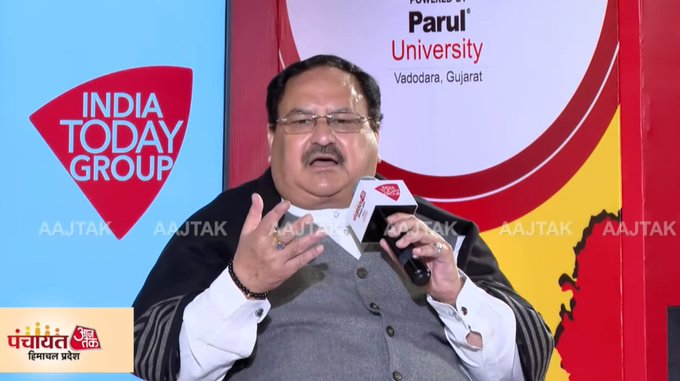‘Scripting’ TV interviews; BJP’s ‘chai pe charcha’ in poll times

By Manish Anand
New Delhi, October 29: After days of advertisements from the official social media handles of the Bharatiya Janata Party (BJP), the television interview of its party chief JP Nadda was broadcast on Saturday. The backdrop is the Assembly elections in Himachal Pradesh and Gujarat.
By now it fits into a pattern, as the BJP media managers plan to turn on the interview events to maximise the narrative reach, beginning with A category of the television channel to cover the last rung when the voting day nears or even on the day when the people queue up outside the polling stations. There is always a long list of television queue for the interviews, with Prime Minister Narendra Modi, Home Minister Amit Shah and Nadda on the wish list of the owners of the visual media houses.
Newspapers have slipped out of the priority of the BJP media managers, and a few are called in to do the formality. Television interview for the BJP is an event on the lines of ‘Chai pe Charcha’ of the Modi launch fame, which was scripted by Prashant Kishor in 2013-14. That event by the maverick marketing agent of politicians and political parties centred on selling unquestioned narrative. Kishor is no more with the BJP, but the party has perfected the art to make the full use of the video-addicted nation to amplify the reach of its slogans through interviews conducted by the celebrity anchors.
Interviews in journalism are meant to produce news values, while unravelling the person being interviewed and questioning his defence system to penetrate deeper in public interest. But the television channels have turned the political interviews in times of elections to allow the stage for peddling unchallenged narrative, with anchors laughing their ways to the perceived company of pals.
Now, the television audience will be treated with marathon prime time interviews of the BJP top guns. The elections of the recent years have shown that the scale of the interview events lean in favour of the BJP. Congress has been staying away from the television channels for several years, with its former party chief Rahul Gandhi accusing on a number of occasions that the media stands compromised. Only a few regional satraps match up to the scale of the television influence of the BJP, which includes Arvind Kejriwal of Aam Aadmi Party, Mamata Banerjee of the Trinamool Congress, MK Stalin of the DMK, K Chandrashekhar Rao of the Telangana Rashtra Party and Jagan Mohan Reddy. Difference indeed is that the regional satraps command television dominance only in their states unlike the BJP, which monopolises the national pre-eminence in the visual media coverage.





